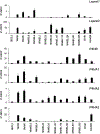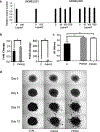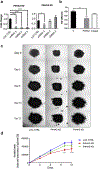Collagen Prolyl Hydroxylases Are Bifunctional Growth Regulators in Melanoma
- PMID: 30452903
- PMCID: PMC7015666
- DOI: 10.1016/j.jid.2018.10.038
Collagen Prolyl Hydroxylases Are Bifunctional Growth Regulators in Melanoma
Abstract
Appropriate post-translational processing of collagen requires prolyl hydroxylation, catalyzed by collagen prolyl 3-hydroxylase and collagen prolyl 4-hydroxylase, and is essential for normal cell function. Here we have investigated the expression, transcriptional regulation, and function of the collagen prolyl 3-hydroxylase and collagen prolyl 4-hydroxylase families in melanoma. We show that the collagen prolyl 3-hydroxylase family exemplified by Leprel1 and Leprel2 is subject to methylation-dependent transcriptional silencing in primary and metastatic melanoma consistent with a tumor suppressor function. In contrast, although there is transcriptional silencing of P4HA3 in a subset of melanomas, the collagen prolyl 4-hydroxylase family members P4HA1, P4HA2, and P4HA3 are often overexpressed in melanoma, expression being prognostic of worse clinical outcomes. Consistent with tumor suppressor function, ectopic expression of Leprel1 and Leprel2 inhibits melanoma proliferation, whereas P4HA2 and P4HA3 increase proliferation, and particularly invasiveness, of melanoma cells. Pharmacological inhibition with multiple selective collagen prolyl 4-hydroxylase inhibitors reduces proliferation and inhibits invasiveness of melanoma cells. Together, our data identify the collagen prolyl 3-hydroxylase and collagen prolyl 4-hydroxylase families as potentially important regulators of melanoma growth and invasiveness and suggest that selective inhibition of collagen prolyl 4-hydroxylase is an attractive strategy to reduce the invasive properties of melanoma cells.
Copyright © 2018 The Authors. Published by Elsevier Inc. All rights reserved.
Conflict of interest statement
CONFLICT OF INTEREST
The authors state no conflict of interest.
Figures






References
Publication types
MeSH terms
Substances
Grants and funding
LinkOut - more resources
Full Text Sources
Other Literature Sources
Medical
Research Materials

